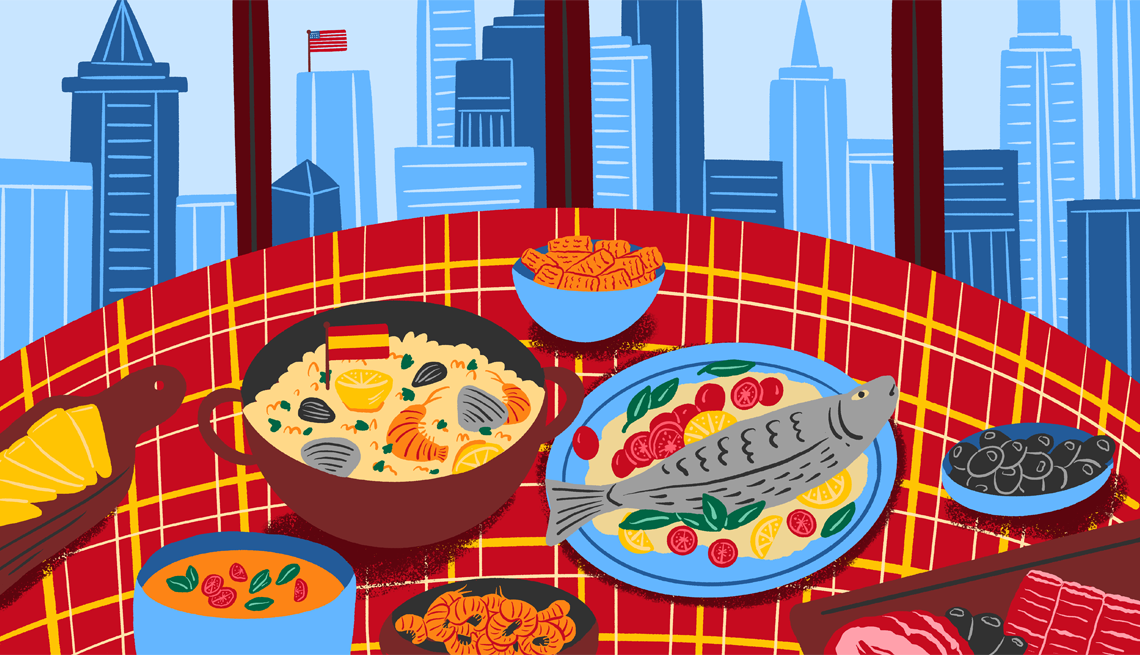
Eating like a spaniard slashed my cholesterol | members only
- Select a language for the TTS:
- UK English Female
- UK English Male
- US English Female
- US English Male
- Australian Female
- Australian Male
- Language selected: (auto detect) - EN
Play all audios:

Burned out after a stressful year and desperate for a lifestyle overhaul, I booked a plane ticket to Spain. When I arrived in Seville, my first stop was a freiduría, or “fry shop” — a
restaurant where virtually the only items on the menu are fried seafood. I usually avoided fried foods because I have high cholesterol, but on this trip I decided I would eat whatever I
wanted … within reason. I was there, after all, to learn how to enjoy life again. In the following weeks, I lived on a diet of manchego cheese, mixed nuts, olives, fish — both fried and
grilled — and farm-fresh vegetables purchased from the local market. I also indulged in the occasional fried churros, chocolate desserts and rich, creamy ice cream. The author in a cooking
class making paella. Aileen Weintraub By the time I headed back to New York, I had gained five pounds and my pants barely buttoned. I braced myself for my upcoming doctor visit: My physician
had already been warning me that he might need to up my cholesterol meds, and I was sure the consequences of my carefree overeating would show up in my bloodwork. But when my tests came
back, my cholesterol levels had dropped almost 40 points! Given all the food — and all the desserts! — how was this possible? I reached out to Michelle Routhenstein, a New York City-based
registered dietician specializing in heart disease, to find out. Routhenstein explained that even though I ate fried foods and indulged in treats, they were likely cooked in heart-healthy
olive oil, a Spanish staple. She also said that while I had my fair share of cheese, I still cut my saturated fat by unintentionally eliminating butter and eggs from my morning routine. My
Spanish breakfast consisted of a slice of bread with tomato paste, cheese or avocado. And while the foods I was eating definitely influenced my cholesterol levels, there were other factors
at play, too. “You were probably walking more, your stress levels were lower, and maybe you had more social connection,” Routhenstein said. These are all factors that influence heart health.
This was all great … if you’re on vacation in Spain. But how could I hold on to the heart-healthy changes now that I was back at work in the U.S.? Here are 10 lessons I learned on my
European vacation, and how I turned them into practical, everyday tricks. 1. I SKIP THE ULTRA-PROCESSED FOOD One of the main contributors to high cholesterol is ultra-processed food,
according to Stanford University Senior Policy Advisor Kavita Patel, M.D. Since the EU bans many ultra-processed foods that are available in the United States, I significantly cut down on
them without realizing it. I was no longer eating additives, sugar, excessive salt, emulsifiers or artificial flavors. “The universal theme with all ultra-processed foods is that they’re
adding something that increases the risk of heart disease, obesity and cholesterol,” says Patel. An inspiring dish from the author's travels in Spain. Aileen Weintraub If I buy food in
a box or bag, I read the ingredients. If there are more than five, or if an ingredient sounds like something made in a lab, it goes back on the shelf. I opt for raw, hard cheese, which is
less processed, richer and more satisfying than pre-shredded or packaged cheese, so I eat less of it. I also keep olives in the house and snack on them instead of chips. 2. I EAT MORE
CHOLESTEROL BLOCKERS “Some foods, like avocado or flax seeds, actually compete with the absorption of cholesterol,” says Jeffrey Berger, M.D., director of the Center of Prevention of
Cardiovascular Disease at NYU Langone. I now eat avocado almost every day to help reduce the cholesterol my body absorbs from food.
